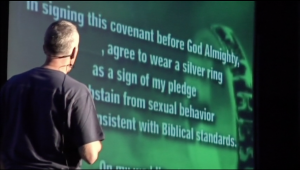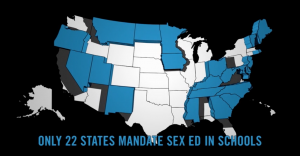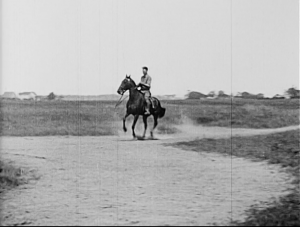Assignment 3: Group Film Review
 Through its depictions of sexual education throughout the years and the opinions of different people, Sex(ed) does a good job of informing and making its point. One of the primary messages of the movie is the importance of good sexual education. Sex(ed) goes through the history of sexual education, primarily through old educational films, and reveals some of the issues that have traditionally plagued sexual education. Sexism (such as the blaming of women for transmitting sexually transmitted infections) and dangers of abstinence-only sexual education are explained and back up the filmmakers’ point about more comprehensive, progressive, and equal sexual education. The film also incorporates data (such as the map toward the end of the film showing which states mandate sexual education and which mandate the education to be factual) that support the idea that sexual education is not common or comprehensive enough.
Through its depictions of sexual education throughout the years and the opinions of different people, Sex(ed) does a good job of informing and making its point. One of the primary messages of the movie is the importance of good sexual education. Sex(ed) goes through the history of sexual education, primarily through old educational films, and reveals some of the issues that have traditionally plagued sexual education. Sexism (such as the blaming of women for transmitting sexually transmitted infections) and dangers of abstinence-only sexual education are explained and back up the filmmakers’ point about more comprehensive, progressive, and equal sexual education. The film also incorporates data (such as the map toward the end of the film showing which states mandate sexual education and which mandate the education to be factual) that support the idea that sexual education is not common or comprehensive enough.
The film provides and refutes counterarguments, such as footage of people arguing for abstinence-only sexual education (or no sexual education whatsoever), which is a good technique for making viewers agree with the filmmakers. However, some of the examples may have been selected simply because they were ridiculously irrational. Refuting some more well-articulated, understandable counterarguments would have been better for conveying the point of the film. Overall, however, Sex(ed) does a good job of making reasonable points that a viewer is inclined to agree with.
Based on how the documentary did their interviews, editing, and transitions between each phase, I could tell a lot of time went into this production. For a documentary like this, having both sexes present in the interview process was important. With a topic like sex education, each interpretation and experience was different, creating an integral part in how the information will be understood. It was also important for the film to pick men and women from different generations. With sex education as the topic, how it has been taught over the years has changed drastically. Thus, creating a wide array of answers to the interview questions.
Transitioning between each phase was smooth, allowing the viewer to receive the message completely. Editing with layers of film and sound was used multiple times throughout the film, whether it was a voiceover happening during an action shot or music playing during an interview. I noticed how the transitioning between interviews was quick, creating multiple opinions on an answer right after the other. Editing background music that fits the answers was also a beneficial tool in grabbing the viewer’s attention. In addition, every interviewee had a different background. Something that can be edited in if you were to have all the interviewees participating with a green screen background. With that said, having interviewees in an actual outdoor or indoor setting, like used in the documentary, would also be beneficial. Like stated in class, none of the people being interviewed are right in front of the camera. Having them offset to the right or left creates a better atmosphere. I noticed that many of the interviewees did not look into the camera directly, but instead at someone as if they were sitting right next to the camera. This can be an integral part in helping create a better-quality film.
 For a documentary film, the interviews are a very important part, that take up a majority of the time. With that said, it is important to put time into editing and transitioning between them so that the information said makes sense. The questions asked before each answer is never stated, so editing the film so that images, archival footage, etc. placed before it, allows for a smooth transition and background for what will be said. Sex(ed) creates that experience making the message much easier to grasp.
For a documentary film, the interviews are a very important part, that take up a majority of the time. With that said, it is important to put time into editing and transitioning between them so that the information said makes sense. The questions asked before each answer is never stated, so editing the film so that images, archival footage, etc. placed before it, allows for a smooth transition and background for what will be said. Sex(ed) creates that experience making the message much easier to grasp.
 This film generally was effective with respect to the filmmakers’ choices in sound, music, and archival footage within the movie. Music was almost entirely limited to relatively quiet, instrumental soundtracks that served as background to the interviews and narration in the film, with the exception of the lyrical songs that went along with some of the video clips shown. I felt that the producers of the movie did well in choosing the music to make up the soundtrack; it enhanced the mood of the movie and fit well with what was being said without being too loud or distracting. There were also times when no music was used, which was also effective in that it kept the viewers’ complete focus on what was being said or shown.
This film generally was effective with respect to the filmmakers’ choices in sound, music, and archival footage within the movie. Music was almost entirely limited to relatively quiet, instrumental soundtracks that served as background to the interviews and narration in the film, with the exception of the lyrical songs that went along with some of the video clips shown. I felt that the producers of the movie did well in choosing the music to make up the soundtrack; it enhanced the mood of the movie and fit well with what was being said without being too loud or distracting. There were also times when no music was used, which was also effective in that it kept the viewers’ complete focus on what was being said or shown.
Archival footage was a major part of the film; it was the primary technique used and likely occupied the majority of the running time. This helped shape and reinforce the film’s purpose, creating a chronological model where the viewer learns about sex education through history. The clips were mainly organized in chronological order, but were also sorted based on what the topic of discussion was at a given point in the movie, such as differences by gender, abstinence, marriage roles, STD’s and many other focal points. I thought that the way the footage was formatted worked well; it allowed viewers to see many clear examples of what was being discussed as well as to listen to commentary on what was being shown. There were also instances where strings of still images were shown rather than video clips, or where small sections of clips were shown in a row, and this also proved effective in conveying a message to the viewer through many real examples of media.
 One of the few potential drawbacks I saw in regard to Sex(Ed) was its lack of use of graphics; unlike many other films, there were few uses of on-screen statistics, charts, or other similar types of effects. While these can be very powerful, I did feel that in the case of this film, the massive amounts of archival footage were the main focus of the movie and they were very effective in their role, so I felt that graphics may not have fit well with the production of the movie and thus even their absence didn’t necessarily have a negative impact. The messages and lessons in this film were generally well expressed without them. Overall, I felt that the filmmakers for this movie made effective choices about these aspects of the film, and it was easy to understand, well put together and successful in imparting the ideas it conveyed.
One of the few potential drawbacks I saw in regard to Sex(Ed) was its lack of use of graphics; unlike many other films, there were few uses of on-screen statistics, charts, or other similar types of effects. While these can be very powerful, I did feel that in the case of this film, the massive amounts of archival footage were the main focus of the movie and they were very effective in their role, so I felt that graphics may not have fit well with the production of the movie and thus even their absence didn’t necessarily have a negative impact. The messages and lessons in this film were generally well expressed without them. Overall, I felt that the filmmakers for this movie made effective choices about these aspects of the film, and it was easy to understand, well put together and successful in imparting the ideas it conveyed.
